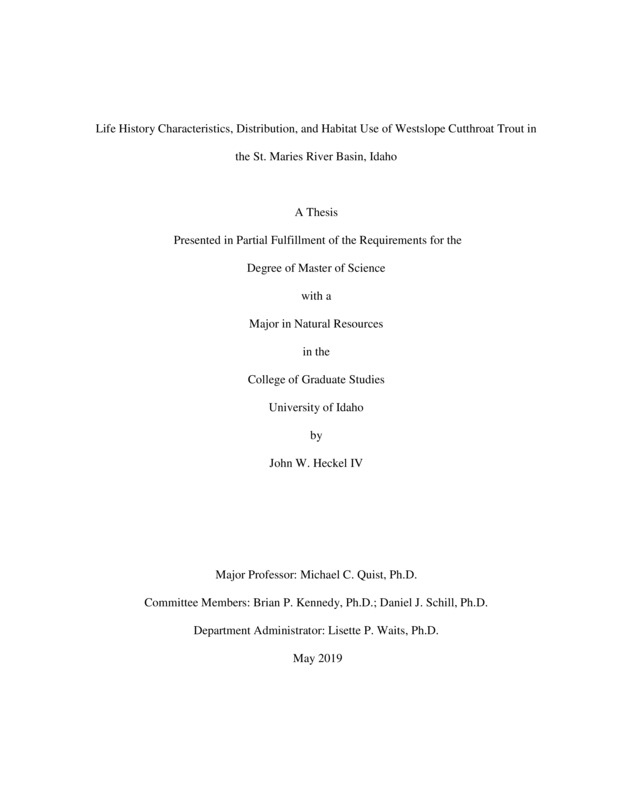Life History Characteristics, Distribution, and Habitat Use of Westslope Cutthroat Trout in the St. Maries River Basin, Idaho
Heckel, John. (2019-05). Life History Characteristics, Distribution, and Habitat Use of Westslope Cutthroat Trout in the St. Maries River Basin, Idaho. Theses and Dissertations Collection, University of Idaho Library Digital Collections. https://www.lib.uidaho.edu/digital/etd/items/heckel_idaho_0089n_11557.html
- Title:
- Life History Characteristics, Distribution, and Habitat Use of Westslope Cutthroat Trout in the St. Maries River Basin, Idaho
- Author:
- Heckel, John
- Date:
- 2019-05
- Keywords:
- Cutthroat Trout Fisheries Fishing Otolith microchemistry Salmonids Trout
- Program:
- Natural Resources
- Subject Category:
- Natural resource management
- Abstract:
-
The distribution and abundance of Westslope Cutthroat Trout Oncorhynchus clarkii lewisi (WCT) in relation to habitat characteristics remains unknown across large portions of its distribution, which includes the St. Maries River basin in northern Idaho. Furthermore, the population structure of WCT in the St. Maries River basin, and whether adfluvial WCT use the St. Maries River basin and contribute to the Coeur d’Alene Lake WCT population is unknown. The goals of this research were multifaceted. One goal was to provide a foundational understanding of WCT distribution and abundance in tributaries of the St. Maries River, Idaho, and to evaluate how WCT were related to habitat characteristics. The second goal of this research was to use strontium isotopes (i.e., 87Sr/86Sr) derived from ambient water and sagittal otoliths to assess spatial variability throughout the Coeur d’Alene Lake watershed and its sub-basins and describe the population structure of WCT in the St. Maries River basin using otolith microchemistry. Westslope Cutthroat Trout were abundant where there was suitable habitat and they were absent in locations with poor habitat or in the presence of Brook Trout Salvelinus fontinalis. Additionally, migratory (i.e., fluvial, adfluvial) and nonmigratory (i.e., resident) life history strategies were detected throughout the watershed. Results of this research suggest that WCT are widely distributed throughout the St. Maries River basin at multiple spatial scales due to life history diversity and connectivity to habitat that supports all life stages.
- Description:
- masters, M.S., Natural Resources -- University of Idaho - College of Graduate Studies, 2019-05
- Major Professor:
- Quist, Michael C
- Committee:
- Carleton, Scott A; Kennedy, Brian P; Schill, Daniel J
- Defense Date:
- 2019-05
- Identifier:
- Heckel_idaho_0089N_11557
- Type:
- Text
- Format Original:
- Format:
- application/pdf
- Rights:
- In Copyright - Educational Use Permitted. For more information, please contact University of Idaho Library Special Collections and Archives Department at libspec@uidaho.edu.
- Standardized Rights:
- http://rightsstatements.org/vocab/InC-EDU/1.0/

